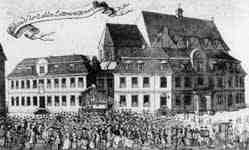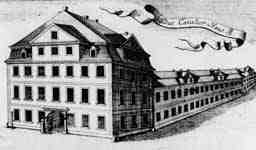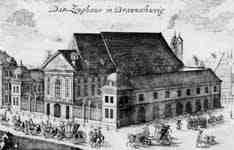Anton August Beck
Illustrations

Braunschweig, Agidienkirche, lottery building from the north

Braunschweig, Bohlweg, Kavaliershaus from northeast

Braunschweig, Bohlweg, armory of the Northeast
Anton August Beck (* 27 August 1713 in Brunswick, 17 March 1787) was a German copper engraver.
life and work
Anton August was the son of the copper engraver Johann Georg Beck from Augsburg and his second wife Anna Elisabeth Füllekrug from Braunschweig. From early childhood he had already gained an insight into the art of copper-engraving. The father died in 1722 when Anton August was barely nine years old. After his mother had married Johann Georg Schmidt in 1725, also a copper cutter coming from Augsburg, the boy was trained by him. His creativity brought him the offer to come to Hanover to settle down there. Beck, however, defeated it, and was appointed Hofkupfertecher on 21 June 1756 by Duke Charles I of Braunschweig-Wolfenbüttel. After the death of the stepfather in 1767, he took over his workshop, which was located in the sack Sack, altitude 7, and successfully continued it. The Kupferstichwerkstatt of father and son Beck existed without interruption from 1706 to 1787.
Beck's many-sided work was, among other things, portraits, such as by Duke Charles I and his wife Philippine Charlotte; But also numerous illustrations for calendars and almanacs, natural representations and (in some cases large format) representations of buildings (churches, city halls, castles) and interior views. For more than 30 years he created the title sheets of the Braunschweigische Anzeige, in which he published five articles on historical topics in and around Braunschweig between 1749 and 1777.
Beck dealt intensively with the history of the city of Braunschweig as well as their topography. In 1758 he created the first exact city map of Braunschweig. His engravings of epitaphs and tombstones provide a comprehensive insight into the family history of Brunswick's civil society. In 1780 he began with an extensive history of the city, but this project remained unfinished. The majority of his works, historically important and created between 1740 and 1780, were finally summarized in the so-called "Becksche Klebeband". The work was a unique source of the history of the town, as Braunschweig was undergoing major architectural changes during the 18th century; Old building structure, partly from the Middle Ages, was removed to give way to new architecture. Beck documented the old as well as the new. Characteristic of his engravings is the soberness of the representation, which wanted to document and not to depict persons and staffages.
A large part of the works of father and son Beck is now in the municipal museum as well as in the Stadtarchiv Braunschweig.
Factory selection
Neustadtrathaus
Sackrathaus
Fountains on the Old Town market
Castle Vechelde
Bevern's Palais Braunschweig
literature
Luitgard Camerer, Manfred Garzmann, Wolf-Dieter Schuegraf (eds.): Braunschweiger Stadtlexikon. Joh. Heinr. Meyer Verlag, Braunschweig 1992, ISBN 3-926701-14-5.
Horst-Rüdiger Jarck, Gerhard Schildt (Eds.): Braunschweigische Landesgeschichte. Millennial backdrop of a region. Braunschweig, 2000, ISBN 3-930292-28-9.
Horst-Rüdiger Jarck, Dieter Lent et al. (Eds.): Braunschweigisches Biographisches Lexikon - 8th to 18th Century. Appelhans Verlag, Braunschweig 2006, ISBN 3-937664-46-7, pp. 71-72.
Gerd Spies: Braunschweig - The image of the city in the 18th century. Works by the Braunschweiger Kupferstecherfamilie Beck. Waisenhaus-Buchdruckerei and publishing house, Braunschweig 1976, ISBN 3-878-84005-5.
----
Fine Art Prints | Greeting Cards | Phone Cases | Lifestyle | Face Masks | Men's , Women' Apparel | Home Decor | jigsaw puzzles | Notebooks | Tapestries | ...
----
Artist
A - B - C - D - E - F - G - H - I - J - K - L - M -
N - O - P - Q - R - S - T - U - V - W - X - Y - Z
Retrieved from "http://en.wikipedia.org/"
All text is available under the terms of the GNU Free Documentation License


